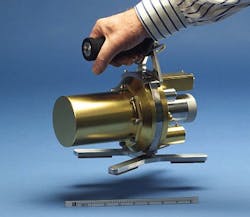Livermore Lab asks for industry's help in commercializing precision hand-held radiation detector
LIVERMORE, Calif., 1 July 2012. Radiation-detection experts at the Lawrence Livermore National Laboratory in Livermore, Calif., are asking for industry's help to license and sell the Livermore-developed Handheld, Fast-cooling Germanium Radiation Detector for identifying hidden illegal radioactive materials.
Livermore scientists developed this radiation detector that cools to operating temperatures in one to two hours. Portable radiation-detection sensor systems typically use electromechanical cooling to make the detector small and lightweight, but can take as long as 12 hours to attain the required temperature, officials say (story continues below).
The Livermore-developed radiation detector uses two separate cooling stages: the first that brings the instrument to operating temperature, and the second -- an embedded cooling system -- that can sustain the detector at its necessary operating temperature for eight to twelve hours.
Scientists at Livermore also have developed an integrated hermetically sealed package that includes user interface, shock mounting, liquid crystal display (LCD), and a USB port connecting to a PC or laptop computer.
An embedded processor runs the display, which shows spectroscopy, isotope identification, system health and status, and other features. The entire packaged system weighs 10.1 pounds including batteries.
Livermore experts have field-tested the integrated radiation-detection system, which they say is at Technical Readiness Level (TRL) 5.
Livermore scientists are looking for industry partners who know how to bring technologies like this to market. Companies interested in commercializing the Livermore Hand-held, Fast-cooling Germanium-based Radiation Detection System should provide a written statement of interest.
Send statements of interest, including company name and address; point of contact; and company description by post to Lawrence Livermore National Laboratory Industrial Partnerships Office, P.O. Box 808, L-795 Livermore, CA 94551-0808, Attention: FBO 255-12.
For questions or concerns contact Livermore's Connie Pitcock by phone at 925-422-1072, or by e-mail at [email protected]. More information is online at https://www.fbo.gov/spg/DOE/LLNL/LL/FBO255-12/listing.html.
Follow Military & Aerospace Electronics and Avionics Intelligence news updates on Twitter
